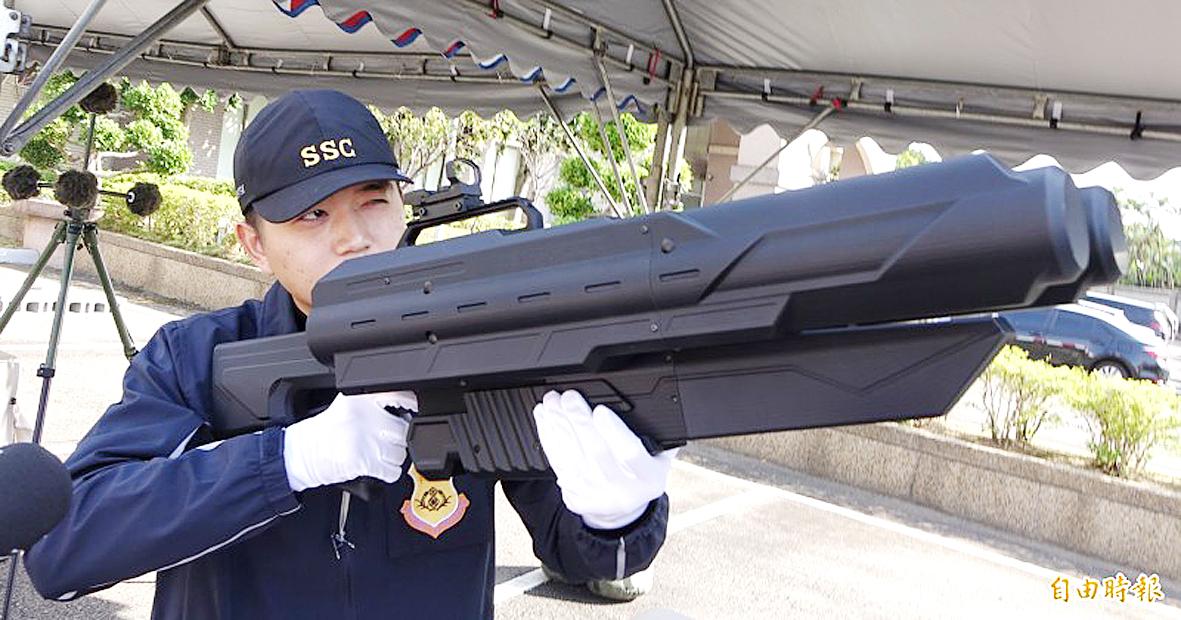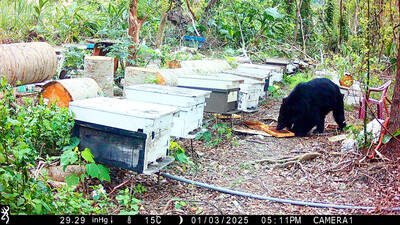The military is looking into countermeasures against the possible use of a “drone swarm” as part of a Chinese “decapitation strike” against Taiwan, a military official said on Saturday.
The comments came after China’s Xinhua news agency reported that Chinese President Xi Jinping (習近平) on Thursday visited the Chinese People’s Liberation Army (PLA) Air Force Aviation University, where he toured its drone experiment labs.
According to the report, Xi instructed the university to put more effort into drone research as the technology is changing how war is conducted, and told the school to improve its production facilities related to drones and step up live combat training for drone operators.

Screen grab from the Liberty Times’ Web site
Beijing has been developing uncrewed aerial and marine vehicles, and has seen marked improvement in its capabilities to use drones, large and small, in strategic deployments and reconnaissance, said a Taiwanese military official, who declined to be named.
The PLA has been focusing on the drone swarm tactic, the official said, adding that the “possibility of Chinese agents in Taiwan operating multiple drones and attacking the Presidential Office, the Executive Yuan or strategic facilities, such as radar stations, cannot be excluded.”
The military has contingencies to handle sudden PLA invasions, attempted decapitation strikes and incidents incited by Chinese agents, and these have been simulated in Han Kuang military exercises, the official said.
Certain agencies have been allocated funding to purchase drone jamming equipment, which has been tested and proven to be effective in countering a potential drone swarm attack on Taiwan, the official added.
In related news, national defense commentator Chieh Chung (?仲) on Friday said that an increase in Chinese nighttime flights near Taiwan’s air defense identification zone (ADIZ) is meant to send a message, to Taiwan and others in the region, that the Chinese air force has significantly improved its combat capability and equipment.
At 7pm on Thursday and 1pm on Friday, PLA jets were sighted in Taiwan’s ADIZ before being chased away, according to reports, although the Ministry of National Defense has not confirmed the sightings, saying that it was “closely monitoring local sea and air activity.”
The first instance of a nighttime sighting of a PLA aircraft near the ADIZ was on March 16, the ministry has said.
That the PLA can overcome the high risk and difficulty in nighttime instrument flights shows a marked improvement in their flight guidance capability and command, control, communications, computer, intelligence, surveillance and reconnaissance ability, Chieh said.
Regarding the increased number of incidents of Chinese military aircraft coming near or crossing into the ADIZ, Chieh said the harassment shows that the PLA Air Force is attempting to strengthen joint-force combat capabilities, step up training for possible combat and ensure distant-strike capability.
A key PLA goal is to keep Taiwan’s southwest ADIZ “under control,” Chieh said, adding that it is highly possible for nighttime Chinese air force activity near the southwest ADIZ to increase.
The ministry should consider measures to ensure that a potential incident would not escalate into a conflict that neither side wants, Chieh said, especially as both sides of the Taiwan Strait lack mutual trust and plans in case of a military incident.

SHIPS, TRAINS AND AUTOMOBILES: The ministry has announced changes to varied transportation industries taking effect soon, with a number of effects for passengers Beginning next month, the post office is canceling signature upon delivery and written inquiry services for international registered small packets in accordance with the new policy of the Universal Postal Union, the Ministry of Transportation and Communications said yesterday. The new policy does not apply to packets that are to be delivered to China, the ministry said. Senders of international registered small packets would receive a NT$10 rebate on postage if the packets are sent from Jan. 1 to March 31, it added. The ministry said that three other policies are also scheduled to take effect next month. International cruise ship operators

NUMBERS IMBALANCE: More than 4 million Taiwanese have visited China this year, while only about half a million Chinese have visited here Beijing has yet to respond to Taiwan’s requests for negotiation over matters related to the recovery of cross-strait tourism, the Tourism Administration said yesterday. Taiwan’s tourism authority issued the statement after Chinese-language daily the China Times reported yesterday that the government’s policy of banning group tours to China does not stop Taiwanese from visiting the country. As of October, more than 4.2 million had traveled to China this year, exceeding last year. Beijing estimated the number of Taiwanese tourists in China could reach 4.5 million this year. By contrast, only 500,000 Chinese tourists are expected in Taiwan, the report said. The report

The Forestry and Nature Conservation Agency yesterday launched a gift box to market honey “certified by a Formosan black bear” in appreciation of a beekeeper’s amicable interaction with a honey-thieving bear. Beekeeper Chih Ming-chen (池明鎮) in January inspected his bee farm in Hualien County’s Jhuosi Township (卓溪) and found that more than 20 beehives had been destroyed and many hives were eaten, with bear droppings and paw prints near the destroyed hives, the agency said. Chih returned to the farm to move the remaining beehives away that evening when he encountered a Formosan black bear only 20m away, the agency said. The bear

Chinese embassy staffers attempted to interrupt an award ceremony of an international tea competition in France when the organizer introduced Taiwan and displayed the Republic of China flag, a Taiwanese tea farmer said in an interview published today. Hsieh Chung-lin (謝忠霖), chief executive of Juxin Tea Factory from Taichung's Lishan (梨山) area, on Dec. 2 attended the Teas of the World International Contest held at the Peruvian embassy in Paris. Hsieh was awarded a special prize for his Huagang Snow Source Tea by the nonprofit Agency for the Valorization of Agricultural Products (AVPA). During the ceremony, two Chinese embassy staffers in attendance